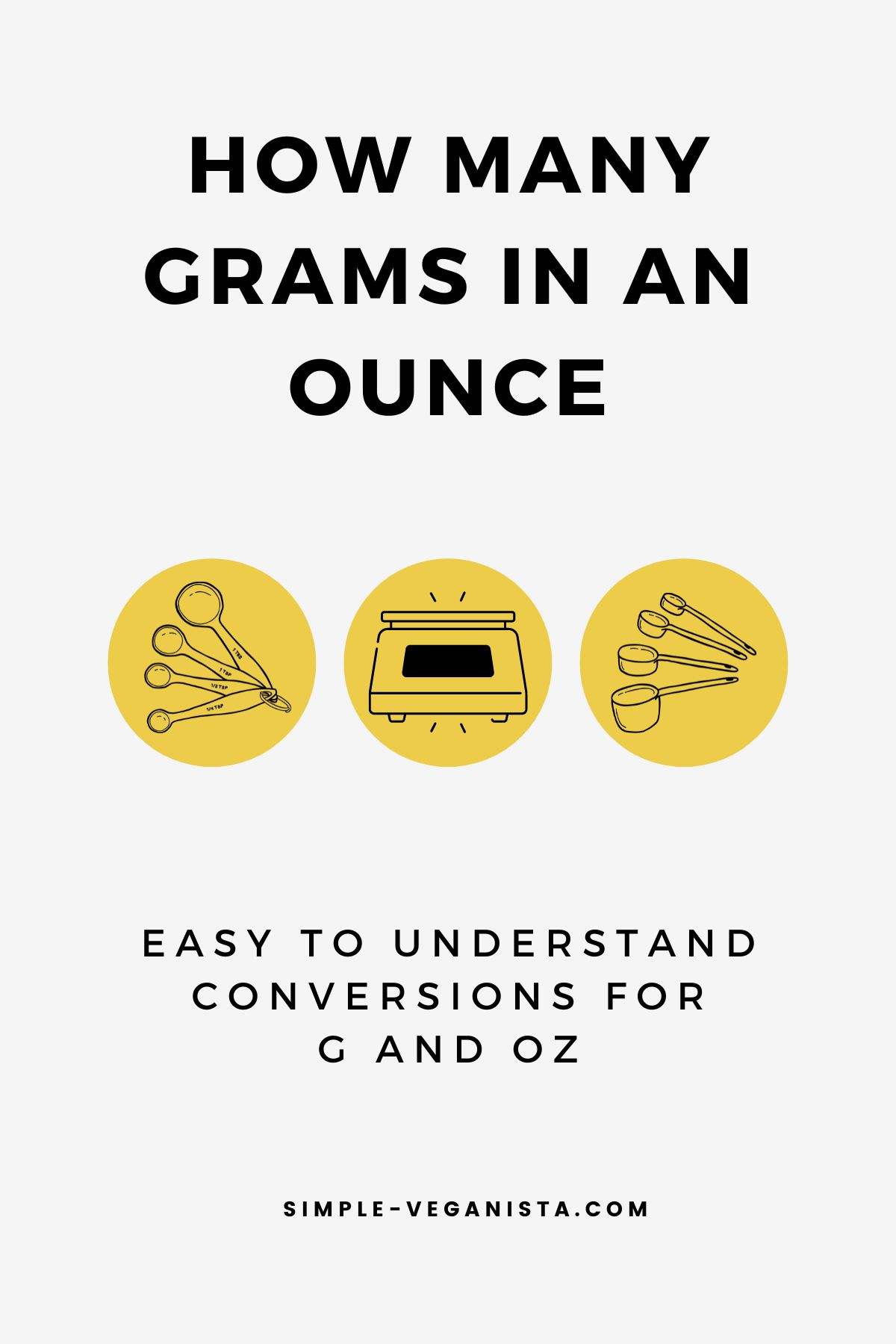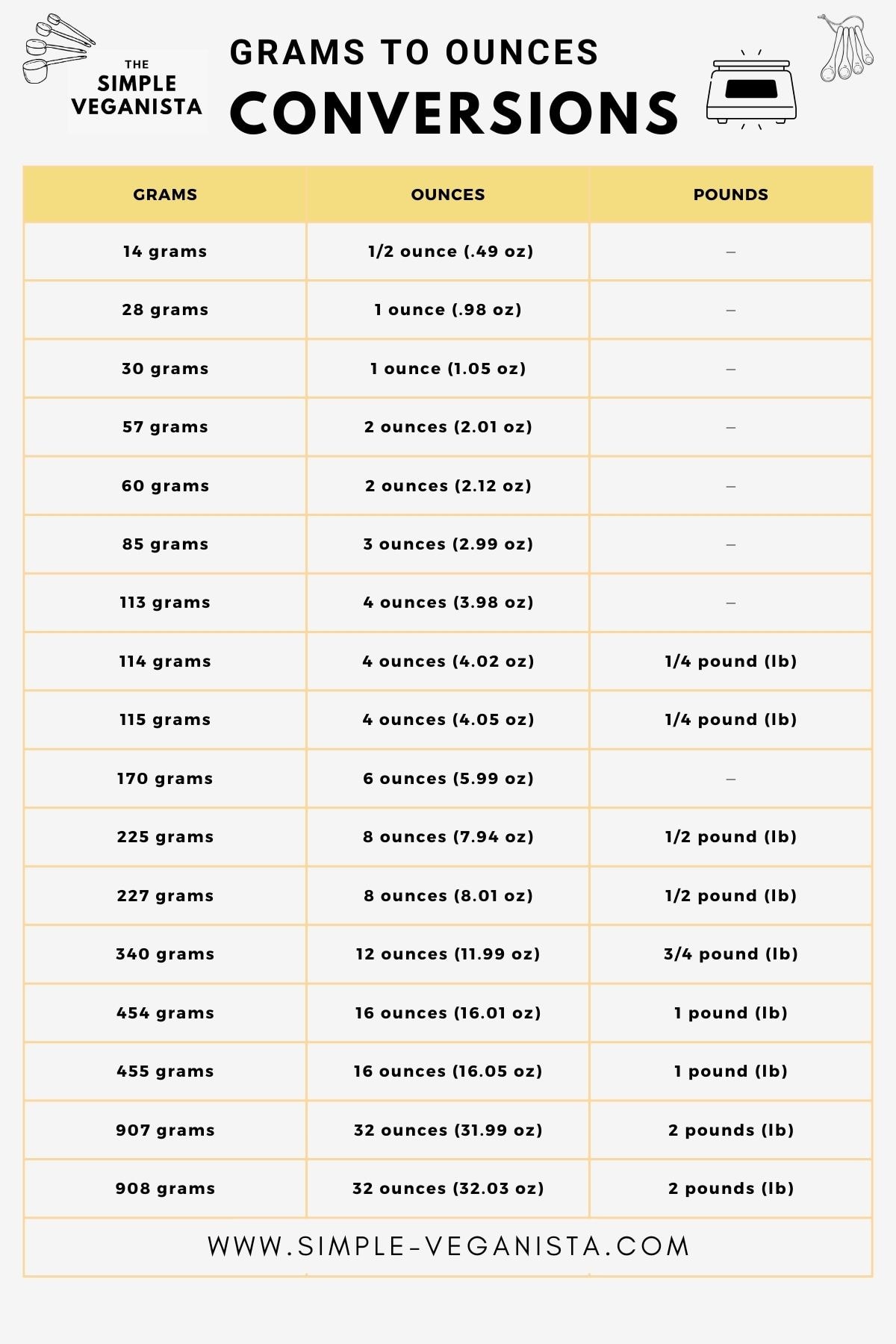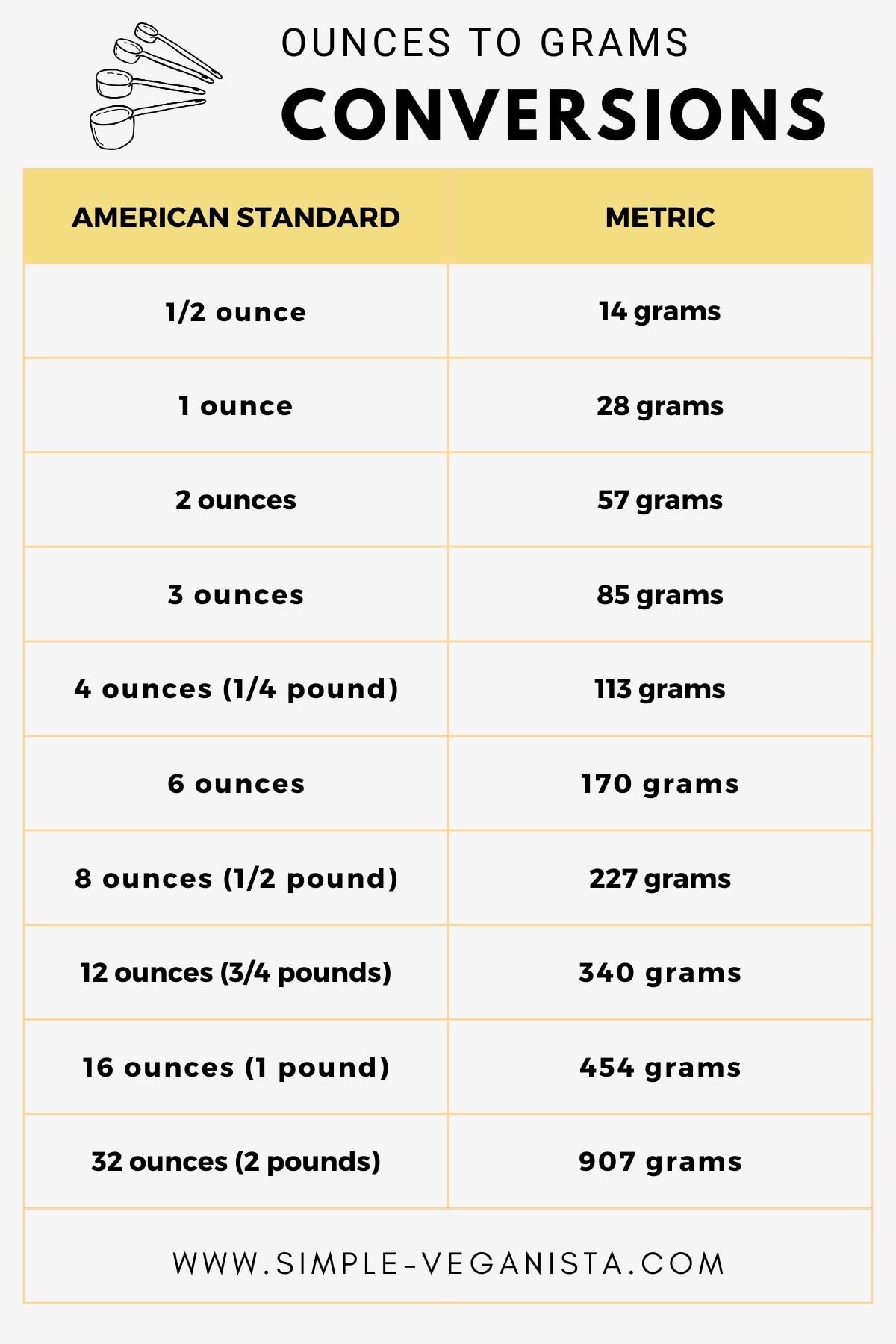How Many Grams in an Ounce (g to oz)
How Many Grams in an Ounce? When making a recipe or DIY project, we’ll answer this often asked question in this guide to weights and measurements for the kitchen and beyond!

Grams and ounces are two of the most common measurement units used worldwide. Grams are used in the metric system, while ounces are used in the imperial system. Both systems are widely used in science, engineering, and, my favorite, cooking.
In cooking, knowing how to convert between grams and ounces is helpful. Many recipes, especially those outside the US, call for ingredients to be measured in grams. If you don’t know how to convert between g and oz, it’s difficult to follow the recipe accurately.
In this post, we’ll break down the number of grams in an ounce. While the answer is straightforward – there are 28 grams in an ounce – the background information behind this measurement deserves a closer look!
Basics of the Imperial and Metric Systems
The Imperial System, which originated in medieval England, is primarily used in the United States and consists of units such as pounds, ounces, and miles.
The Metric System, developed in France during the late 18th century, is the international standard for weights and measures, featuring units like kilograms, grams, and meters.
While the Imperial System is based on arbitrary relationships between units, the Metric System is designed around the powers of ten, making it more intuitive and easier to use.
What is an Ounce?
The ounce, derived from the Latin word “uncia,” is a unit of weight in the Imperial System, typically used for measuring smaller quantities.
It is crucial to distinguish between fluid ounces, which measure volume, and weight ounces, which measure mass.
Ounces are commonly used in daily life for weighing food items, precious metals, and small packages.
There are two primary types of ounces: Troy ounces, used for precious metals, and Avoirdupois ounces, used for most other purposes (and what we will be using in this post).
What is a Gram?
The gram, originating from the French word “gramme,” is a unit of mass in the Metric System, suitable for measuring small amounts of substances.
Grams play a crucial role in the metric system, as one-thousandth of a kilogram, the base unit of mass.
Grams are used in daily life for measuring food portions, ingredients in recipes, and small objects.
What is the Difference Between Grams and Ounces?
An ounce is a unit of measurement for weight, while a gram is a unit of measurement for mass. An ounce is equal to 28.34952 grams, while a gram is equal to 0.03527352735 ounces.
How Many Grams in an Ounce?
Now for the answer to this commonly asked question. Drum roll, please…. 🥁
There are 28 grams in an ounce. This unit conversion can be expressed as 28 grams = 1 ounce or 28 g = 1 oz. However you write it, there are 28 grams in one avoirdupois ounce. In a more precise conversion, 1 ounce is equal to approximately 28.3495 grams (or 28.35 g).
Converting Grams to Ounces
To convert grams to ounces, use the conversion formula: 1 gram = 0.03527396 ounces.
Follow these steps to convert grams to ounces:
- Identify the weight in grams.
- Multiply (x) the weight by the conversion factor (0.03527396).
- The result is the weight in ounces.
base-10 system, making conversions within the system straightforward.
Example: Let’s say you have a package of almonds that weighs 150 grams, and you’d like to convert that weight to ounces.
Using the conversion factor of 1 gram = 0.03527396 ounces, you would multiply the number of grams by the conversion factor:
150 grams × 0.03527396 ounces/gram ≈ 5.291094 ounces
So, 150 grams of almonds is approximately equal to 5.291094 ounces.
Here’s a table showing the conversion between grams and ounces:
| Grams | Ounces |
|---|---|
| 14 g | ½ oz (0.49383547) |
| 28 g | 1 oz (0.98767093) |
| 30 g | 1 oz (1.05821886) |
| 57 g | 2 oz (2.01061583) |
| 60 g | 2 oz (2.11643772) |
| 85 g | 3 oz (2.99828677) |
| 113 g | 4 oz (3.98595770) |
| 114 g | 4 oz (4.02123166) |
| 115 g | 4 oz, 1/4 pound (4.05650562) |
| 170 g | 6 oz (170.09712) |
| 225 g | 8 oz (7.93664144) |
| 227 g | 8 oz, 1/2 pound (8.00718936) |
| 340 g | 12 oz, 3/4 pound (11.99314706) |
| 454 g | 16 oz, 1 pound (16.01437873) |
| 455 g | 16 oz (16.04965269) |
| 907 g | 32 oz, 2 pounds (31.99348349) |
| 908 g | 32 oz, 2 pounds (32.02875745) |
Here is a chart to save for later reference! 📌

Converting Ounces to Grams
To convert ounces to grams, use the conversion factor: 1 ounce = 28.3495 grams.
Follow these steps to convert ounces to grams:
- Identify the weight in ounces.
- Multiply (x) the weight by the conversion factor (28.3495).
- The result is the weight in grams.
Example: Converting 4 ounces to grams: 4 ounces x 28.3495 = 113.398 grams.
| Ounces | Grams |
|---|---|
| 1/8 oz | 3.5 g |
| 1/4 oz | 7 g |
| 1/3 oz | 9 g |
| 1/2 oz | 14 g |
| 3/4 oz | 21 g |
| 1 oz | 28 g |
| 2 oz | 57 g |
| 3 oz | 85 g |
| 4 oz (¼ pound) | 113 g |
| 6 oz | 170 g |
| 8 oz (1/2 pound) | 227 g |
| 12 oz (3/4 pound) | 340 g |
| 16 oz (1 pound) | 454 g |
| 32 oz (2 pounds) | 907 g |
📌 Grams to Ounces Conversion Chart
Here is a handy chart for converting common gram and ounce measurements:
Pin this chart for later!

How To Measure Dry Weight
A digital kitchen scale makes measuring grams accurately quick and precise. Simply place your ingredient in a container on the scale, tare it to zero, and add the desired amount. The scale will display the exact weight in grams, making your measurements a snap.
Alternatively, when working with common ingredients like butter, sugar, or flour for recipes such as cookies or muffins, measuring spoons and cups can come in handy. To approximate grams, fill the spoons or cups with the ingredient, level it off, and refer to common conversion charts or factors. Though not as accurate as a scale, measuring spoons and cups can still be useful in a pinch for everyday cooking and baking tasks.
Tips for Accurate Measurements Every Time
Here are helpful tips in detail when using a scale or measuring cups and spoons:
Scale
Measuring grams with a digital scale is best for accuracy and ease of use. Here’s how to measure grams with a digital scale:
- Choose the right digital scale: Select a scale that meets your needs in terms of capacity, accuracy, and units. Kitchen scales are perfect for measuring food ingredients, while precision scales are designed for measuring small quantities, such as in jewelry or laboratory settings.
- Place the scale on a flat, stable surface: Make sure the surface is level and free from vibrations to obtain accurate measurements.
- Turn on the scale and select the unit: Press the power button to turn on the scale. If your scale has multiple units of measurement, press the “Unit” or “Mode” button to select grams (g).
- Tare or zero the scale: Place an empty container or tray on the scale to hold the item you want to measure. Press the “Tare” or “Zero” button to reset the scale to zero, accounting for the weight of the container.
- Add the item to the container: Slowly add the item you want to measure to the container, ensuring that the item’s weight is evenly distributed. Wait for the scale to stabilize and display the final weight.
- Record the measurement: Take note of the measurement displayed on the scale, which should be in grams.
Measuring Spoons and Cups
Measuring spoons and cups are a handy alternative for weighing ingredients without a scale. However, they measure volume, making conversions between grams and ounces less precise. Follow these tips for approximating weight measurements with spoons and cups:
- Familiarize yourself with common conversions: Learn the approximate gram-to-ounce conversions for common ingredients. For example, 1 cup of all-purpose flour weighs around 125 grams, while 1 cup of granulated sugar weighs about 200 grams.
- Use appropriate measuring tools: Use measuring cups for dry ingredients and measuring spoons or liquid measuring cups for wet ingredients.
- Level off dry ingredients: When measuring dry ingredients with measuring cups or spoons, use the flat edge of a knife or a straight-edged spatula to level off the ingredient, ensuring an accurate measurement.
- Spoon and level method: For ingredients like flour or powdered sugar, use a spoon to scoop the ingredient into the measuring cup and then level it off. This prevents overpacking and maintains consistency in measurements.
- Pack when necessary: Some ingredients, like brown sugar, need to be packed firmly into the measuring cup to ensure an accurate measurement.
- Don’t scoop directly: Avoid scooping dry ingredients directly from their container with the measuring cup, as this can cause the ingredient to compact, leading to inaccurate measurements.
- Convert the measurements: After measuring the ingredients by volume, use approximate conversion factors or charts to estimate the weight in grams or ounces.
Other Practical Tips
Use a conversion chart. There are many conversion charts available online and in cookbooks. If you don’t have a kitchen scale, a conversion chart is an easy wat to convert between grams and ounces.
Be sure to use the correct units of measurement. If you use the wrong units of measurement, your recipe may not turn out as expected. For example, if a recipe calls for 10 grams of butter, you can’t use 10 ounces of butter.
Practice makes perfect. Practice estimating conversions without a scale by familiarizing yourself with common reference points (e.g., a teaspoon equals about 5 grams).
FAQ’s
How many grams are in an ounce of chocolate?
There are 28.3495 grams in an ounce of chocolate. This means that if you have a chocolate bar that weighs 8 ounces, it will contain 228.3495 grams of chocolate.
How many grams are in an ounce of water?
There are exactly 28.3495 grams in an ounce of water.
How many grams are in an ounce of food?
The weight of an ounce of food in grams depends on the type of food and its density. However, the general conversion factor between ounces and grams is 1 ounce = 28.3495 grams.
To determine the weight of an ounce of food in grams, you can use this conversion factor. Keep in mind that different types of food may have different densities, so the actual weight might vary slightly. In general, one ounce of food would be approximately 28.3495 grams.
